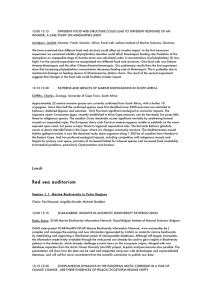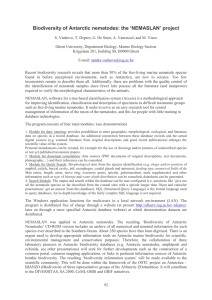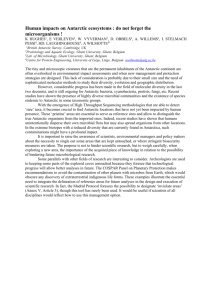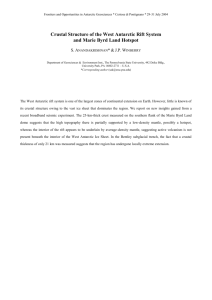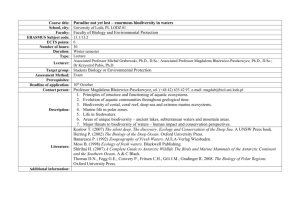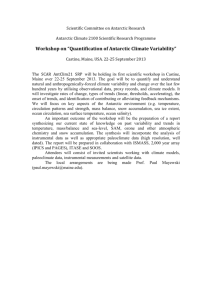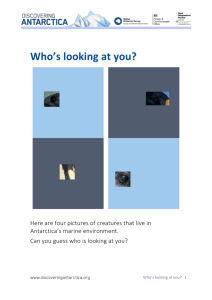1.2. The Census of Antarctic Marine Life (CAML) CAML Michael Stoddart
advertisement
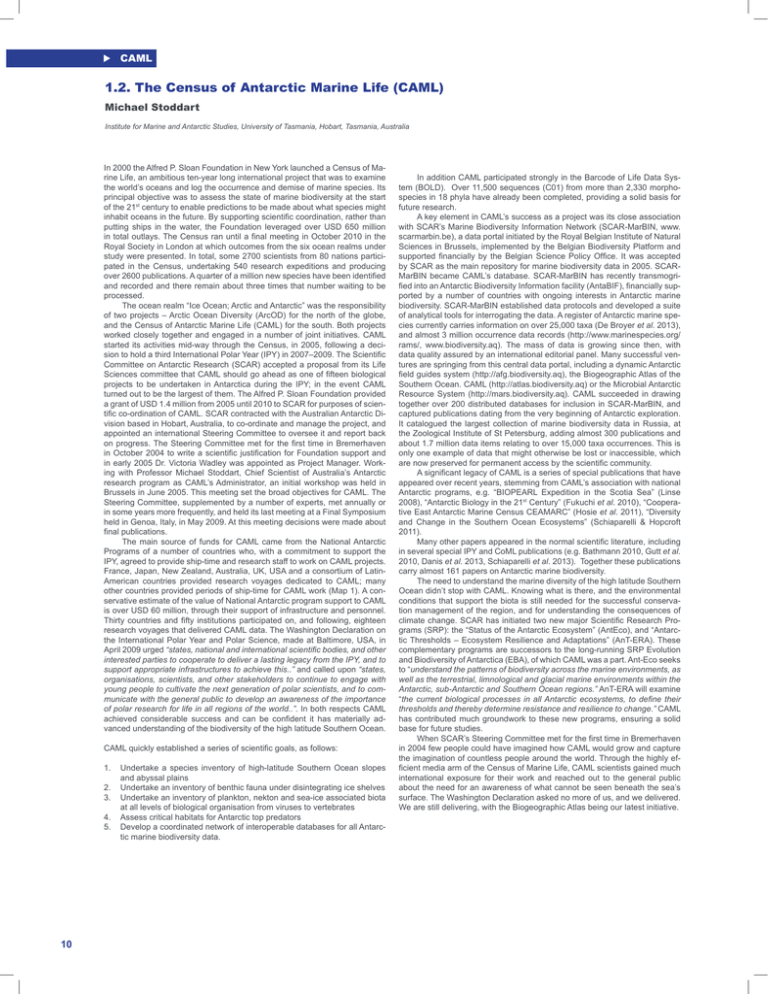
CAML 1.2. The Census of Antarctic Marine Life (CAML) Michael Stoddart Institute for Marine and Antarctic Studies, University of Tasmania, Hobart, Tasmania, Australia In 2000 the Alfred P. Sloan Foundation in New York launched a Census of Marine Life, an ambitious ten-year long international project that was to examine the world’s oceans and log the occurrence and demise of marine species. Its principal objective was to assess the state of marine biodiversity at the start of the 21st century to enable predictions to be made about what species might inhabit oceans in the future. By supporting scientific coordination, rather than putting ships in the water, the Foundation leveraged over USD 650 million in total outlays. The Census ran until a final meeting in October 2010 in the Royal Society in London at which outcomes from the six ocean realms under study were presented. In total, some 2700 scientists from 80 nations participated in the Census, undertaking 540 research expeditions and producing over 2600 publications. A quarter of a million new species have been identified and recorded and there remain about three times that number waiting to be processed. The ocean realm “Ice Ocean; Arctic and Antarctic” was the responsibility of two projects – Arctic Ocean Diversity (ArcOD) for the north of the globe, and the Census of Antarctic Marine Life (CAML) for the south. Both projects worked closely together and engaged in a number of joint initiatives. CAML started its activities mid-way through the Census, in 2005, following a decision to hold a third International Polar Year (IPY) in 2007–2009. The Scientific Committee on Antarctic Research (SCAR) accepted a proposal from its Life Sciences committee that CAML should go ahead as one of fifteen biological projects to be undertaken in Antarctica during the IPY; in the event CAML turned out to be the largest of them. The Alfred P. Sloan Foundation provided a grant of USD 1.4 million from 2005 until 2010 to SCAR for purposes of scientific co-ordination of CAML. SCAR contracted with the Australian Antarctic Division based in Hobart, Australia, to co-ordinate and manage the project, and appointed an international Steering Committee to oversee it and report back on progress. The Steering Committee met for the first time in Bremerhaven in October 2004 to write a scientific justification for Foundation support and in early 2005 Dr. Victoria Wadley was appointed as Project Manager. Working with Professor Michael Stoddart, Chief Scientist of Australia’s Antarctic research program as CAML’s Administrator, an initial workshop was held in Brussels in June 2005. This meeting set the broad objectives for CAML. The Steering Committee, supplemented by a number of experts, met annually or in some years more frequently, and held its last meeting at a Final Symposium held in Genoa, Italy, in May 2009. At this meeting decisions were made about final publications. The main source of funds for CAML came from the National Antarctic Programs of a number of countries who, with a commitment to support the IPY, agreed to provide ship-time and research staff to work on CAML projects. France, Japan, New Zealand, Australia, UK, USA and a consortium of LatinAmerican countries provided research voyages dedicated to CAML; many other countries provided periods of ship-time for CAML work (Map 1). A conservative estimate of the value of National Antarctic program support to CAML is over USD 60 million, through their support of infrastructure and personnel. Thirty countries and fifty institutions participated on, and following, eighteen research voyages that delivered CAML data. The Washington Declaration on the International Polar Year and Polar Science, made at Baltimore, USA, in April 2009 urged “states, national and international scientific bodies, and other interested parties to cooperate to deliver a lasting legacy from the IPY, and to support appropriate infrastructures to achieve this..” and called upon “states, organisations, scientists, and other stakeholders to continue to engage with young people to cultivate the next generation of polar scientists, and to communicate with the general public to develop an awareness of the importance of polar research for life in all regions of the world..”. In both respects CAML achieved considerable success and can be confident it has materially advanced understanding of the biodiversity of the high latitude Southern Ocean. CAML quickly established a series of scientific goals, as follows: 1. Undertake a species inventory of high-latitude Southern Ocean slopes and abyssal plains 2. Undertake an inventory of benthic fauna under disintegrating ice shelves 3. Undertake an inventory of plankton, nekton and sea-ice associated biota at all levels of biological organisation from viruses to vertebrates 4. Assess critical habitats for Antarctic top predators 5. Develop a coordinated network of interoperable databases for all Antarctic marine biodiversity data. 10 In addition CAML participated strongly in the Barcode of Life Data System (BOLD). Over 11,500 sequences (C01) from more than 2,330 morphospecies in 18 phyla have already been completed, providing a solid basis for future research. A key element in CAML’s success as a project was its close association with SCAR’s Marine Biodiversity Information Network (SCAR-MarBIN, www. scarmarbin.be), a data portal initiated by the Royal Belgian Institute of Natural Sciences in Brussels, implemented by the Belgian Biodiversity Platform and supported financially by the Belgian Science Policy Office. It was accepted by SCAR as the main repository for marine biodiversity data in 2005. SCARMarBIN became CAML’s database. SCAR-MarBIN has recently transmogrified into an Antarctic Biodiversity Information facility (AntaBIF), financially supported by a number of countries with ongoing interests in Antarctic marine biodiversity. SCAR-MarBIN established data protocols and developed a suite of analytical tools for interrogating the data. A register of Antarctic marine species currently carries information on over 25,000 taxa (De Broyer et al. 2013), and almost 3 million occurrence data records (http://www.marinespecies.org/ rams/, www.biodiversity.aq). The mass of data is growing since then, with data quality assured by an international editorial panel. Many successful ventures are springing from this central data portal, including a dynamic Antarctic field guides system (http://afg.biodiversity.aq), the Biogeographic Atlas of the Southern Ocean. CAML (http://atlas.biodiversity.aq) or the Microbial Antarctic Resource System (http://mars.biodiversity.aq). CAML succeeded in drawing together over 200 distributed databases for inclusion in SCAR-MarBIN, and captured publications dating from the very beginning of Antarctic exploration. It catalogued the largest collection of marine biodiversity data in Russia, at the Zoological Institute of St Petersburg, adding almost 300 publications and about 1.7 million data items relating to over 15,000 taxa occurrences. This is only one example of data that might otherwise be lost or inaccessible, which are now preserved for permanent access by the scientific community. A significant legacy of CAML is a series of special publications that have appeared over recent years, stemming from CAML’s association with national Antarctic programs, e.g. “BIOPEARL Expedition in the Scotia Sea” (Linse 2008), “Antarctic Biology in the 21st Century” (Fukuchi et al. 2010), “Cooperative East Antarctic Marine Census CEAMARC” (Hosie et al. 2011), “Diversity and Change in the Southern Ocean Ecosystems” (Schiaparelli & Hopcroft 2011). Many other papers appeared in the normal scientific literature, including in several special IPY and CoML publications (e.g. Bathmann 2010, Gutt et al. 2010, Danis et al. 2013, Schiaparelli et al. 2013). Together these publications carry almost 161 papers on Antarctic marine biodiversity. The need to understand the marine diversity of the high latitude Southern Ocean didn’t stop with CAML. Knowing what is there, and the environmental conditions that support the biota is still needed for the successful conservation management of the region, and for understanding the consequences of climate change. SCAR has initiated two new major Scientific Research Programs (SRP): the “Status of the Antarctic Ecosystem” (AntEco), and “Antarctic Thresholds – Ecosystem Resilience and Adaptations” (AnT-ERA). These complementary programs are successors to the long-running SRP Evolution and Biodiversity of Antarctica (EBA), of which CAML was a part. Ant-Eco seeks to “understand the patterns of biodiversity across the marine environments, as well as the terrestrial, limnological and glacial marine environments within the Antarctic, sub-Antarctic and Southern Ocean regions.” AnT-ERA will examine “the current biological processes in all Antarctic ecosystems, to define their thresholds and thereby determine resistance and resilience to change.” CAML has contributed much groundwork to these new programs, ensuring a solid base for future studies. When SCAR’s Steering Committee met for the first time in Bremerhaven in 2004 few people could have imagined how CAML would grow and capture the imagination of countless people around the world. Through the highly efficient media arm of the Census of Marine Life, CAML scientists gained much international exposure for their work and reached out to the general public about the need for an awareness of what cannot be seen beneath the sea’s surface. The Washington Declaration asked no more of us, and we delivered. We are still delivering, with the Biogeographic Atlas being our latest initiative. Map 1 Akademik Fedorov, 2007/08 Ary Rongel, 2007/08 Aurora Australis, 2007/08 James Clark Ross, 2007/08 L’Astrolabe, 2007/08 Papanin, 2008-2009 Polarstern, 2006/07 Polarstern, 2007/08 Tangaroa, 2007/08 Umitaka Maru, 2007/08 Yuzhmorgeologiya, 2007/08 CAML Map 1 Tracks of selected CAML-dedicated cruises Acknowledgments Huw Griffiths (BAS, Cambridge) and Anton Van de Putte (RBINS, Brussels) prepared the map. This is CAML contribution # 89. References Bathmann, U. (ed.), 2010. The expedition of the Research Vessel «Polarstern» to the Antarctic in 2007/2008 (ANT-XXIV/2). Berichte zur Polar- und Meeresforschung, 604, 1–200. Convey, P., Chown, S.L., Clarke, A., Barnes, D.K.A., Bokhorst, S., Cummings, V., Ducklow, H.W., Frati, F., Green, T.G.A., Gordon, S., Griffiths, H.J., Howard-Williams, C., Huiskes, A.H.L., Laybourn-Parry, J., Lyons, W.B., McMinn, A., Morley, S.A., Peck, L.S., Quesada, A., Robinson, S.A., Schiaparelli, S., Wall, D.H., (In press). The spatial structure of Antarctic biodiversity. Ecological Monographs (ISSN:0012-9615). De Broyer, C., Danis, B., 2011. How many species in the Southern Ocean? Towards a dynamic inventory of Antarctic marine species. Deep Sea Research Part II: Topical Studies in Oceanography, 58(1–2), 1–276. Fukuchi, M., Hodgson, D., di Prisco, G., Hosie, G., Bergstrom, D. (eds.), 2010. Antarctic Biology in the 21st Century - Advances in and beyond IPY. Polar Science, 4(2), 93–430. Gutt, J., Hosie, G., Stoddart, M., 2010. Marine Life in the Antarctic. In: McIntyre, A.D. (ed.), Life in the world’s oceans: diversity, distribution, and abundance, Oxford: Blackwell Publishing Ltd, pp. 203–220. Hosie, G., Fukuchi, M., Koubbi, P., Moteki, M., Ozouf-Costaz, C., Riddle, M. (eds.), 2011. CEAMARC - The Collaborative East Antarctic Marine Census for the Census of Antarctic Marine Life Polar Science, 5(2), 75–312. Kaiser, S., Brandao, S.N., Brix, S., Barnes, D.K.A., Bowden, D.A., Ingels, J., Leese, F., Schiaparelli, S., Arango, C.P., Badhe, R., Bax, N., Blazewicz-Paszkowycz, M., Brandt, A., Brenke, N., Catarino, A.I., David, B., De Ridder, C., Dubois, P., Ellingsen, K.E., Glover, A.G., Griffiths, H.J., Gutt, J., Halanych, K.M., Havermans, C., Held, C., Janussen, D., Loerz, A.-N., Pearce, D.A., Pierrat, B., Riehl, T., Rose, A., Sands, C.J., Soler-Membrives, A., Schuller, M., Strugnell, J.M., Vanreusel, A., Veit-Kohler, G., Wilson, N.G., Yasuhara, M., 2013. Patterns, processes and vulnerability of Southern Ocean benthos: a decadal leap in knowledge and understanding. Marine Biology, 160, 2295- 2317. Linse, K. (ed), 2008. BIOPEARL Cruise in the Scotia Sea. Antarctic Science, 20 (Special Issue 03), 209–310. Schiaparelli, S., Hopcroft, R.R. (eds.), 2011. Census of Antarctic Marine Life: Diversity and Change in the Southern Ocean Ecosystems. Deep Sea Research Part II: Topical Studies in Oceanography, 58(1–2), 1–276. Schiaparelli, S., Danis, B., Wadley, V., Stoddart, D.M., 2013. The Census of Antarctic Marine Life: the first available baseline for Antarctic marine biodiversity. In: Verde, C., di Prisco, G. (eds.). Adaptation and Evolution in Marine Environments, Volume 2, From Pole to Pole, pp. 1–19. doi:10.1007/978-3-642-27349-0_1 Biogeographic Atlas of the Southern Ocean 11
